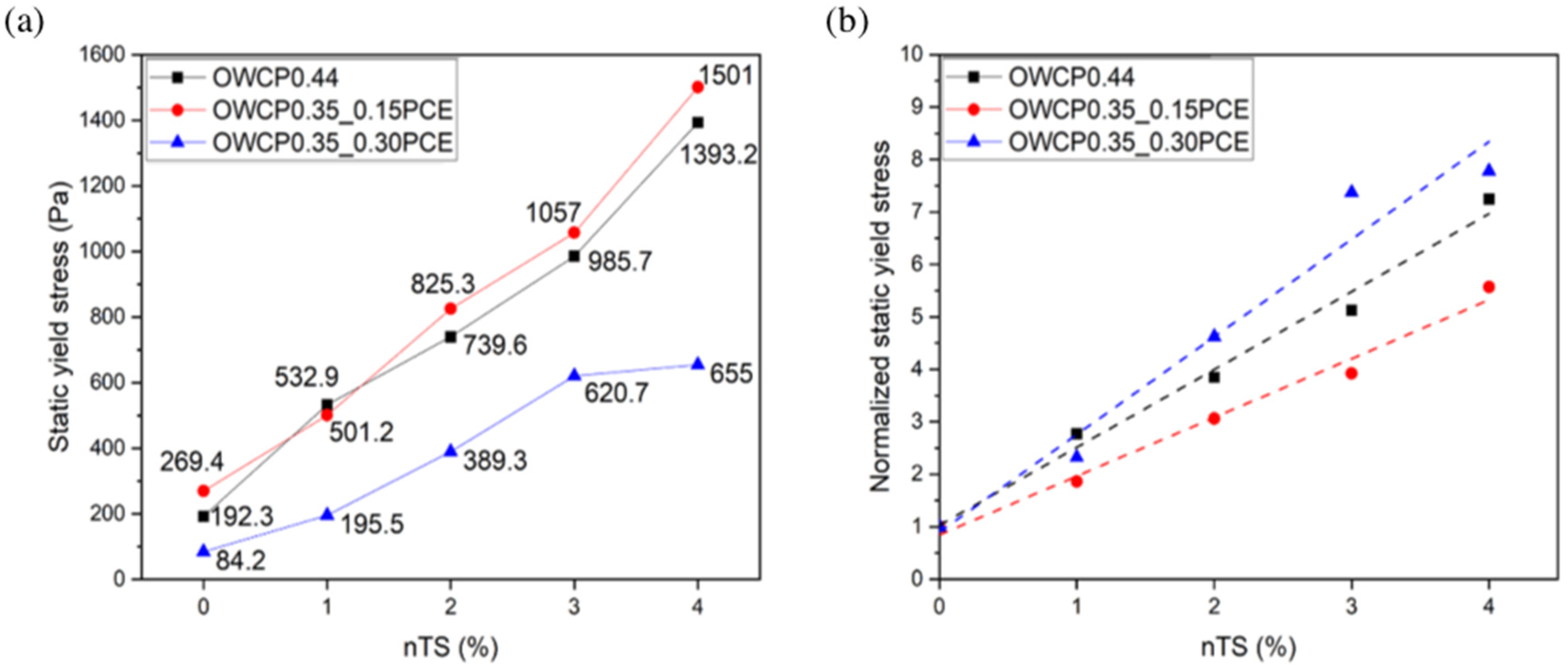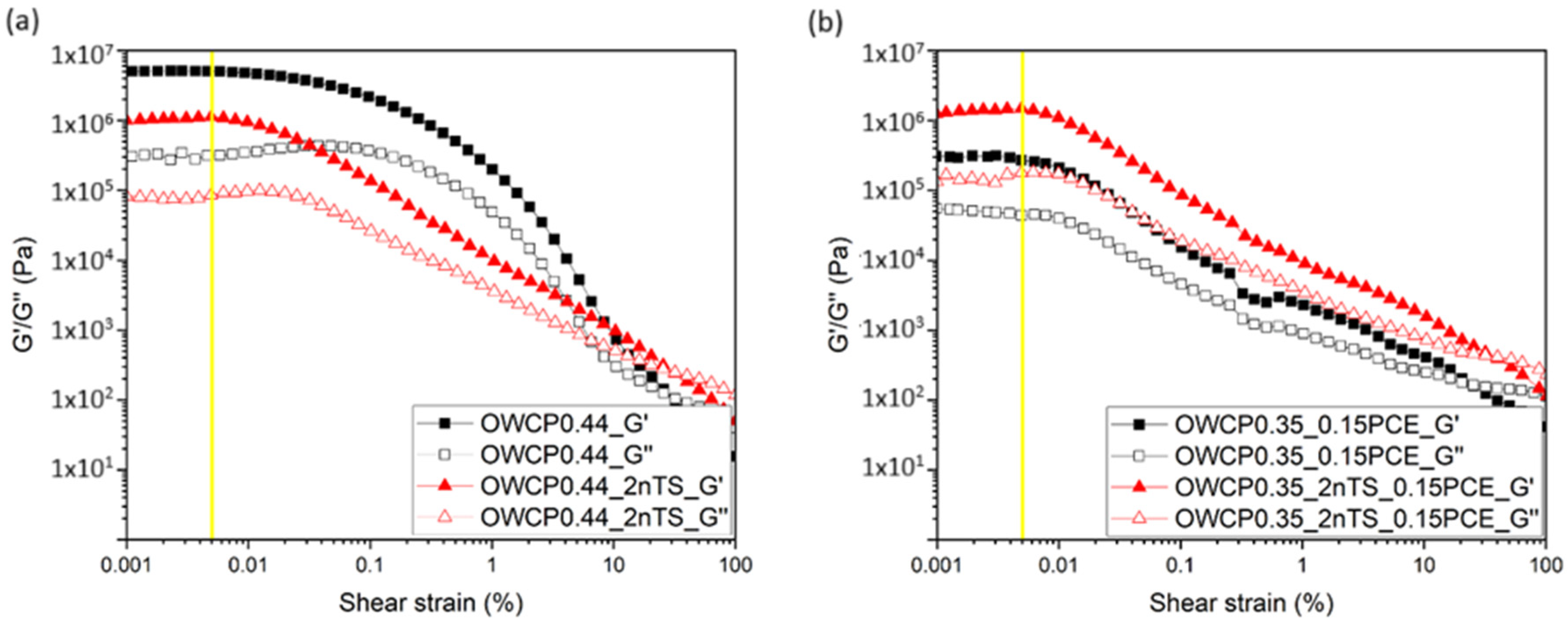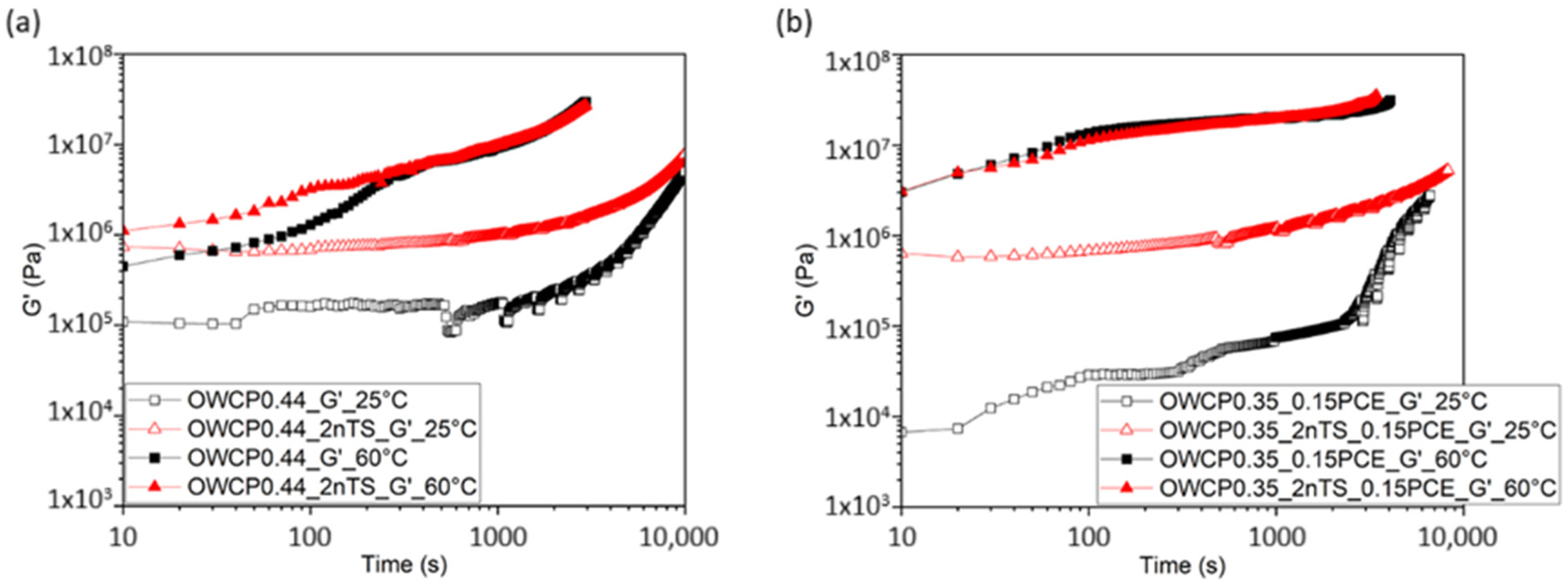Rheological Behavior of Oil Well Cement Slurries with Addition of Core/Shell TiO2@SiO2 Nanoparticles—Effect of Superplasticizer and Temperature
Abstract
:1. Introduction
2. Materials and Methods
2.1. Materials
2.2. Mixing Procedures
2.3. Rheological Test Conditions
2.3.1. Static Yield Stress
2.3.2. Flow Curves and Apparent Viscosity
2.3.3. Oscillation Tests
3. Results and Discussion
3.1. Impact of nTS and PCE on the Static and Dynamic Yield Stress of Oil Well Cement Pastes at Room Temperature
3.2. Impact of the Temperature and nTS on the Dynamic Yield Stress and Apparent Viscosity of the Oil Well Cement Pastes
3.3. Study of the Reactivity of the Oil Well Cement Pastes Containing nTS by Oscillation Rheometry
4. Conclusions
Supplementary Materials
Author Contributions
Funding
Institutional Review Board Statement
Informed Consent Statement
Data Availability Statement
Acknowledgments
Conflicts of Interest
References
- Kumar, S.; Bera, A.; Shah, S.N. Potential Applications of Nanomaterials in Oil and Gas Well Cementing: Current Status, Challenges and Prospects. J. Pet. Sci. Eng. 2022, 213, 110395. [Google Scholar] [CrossRef]
- Hodne, H.; Saasen, A.; O’Hagan, A.B.; Wick, S.O. Effects of Time and Shear Energy on the Rheological Behaviour of Oilwell Cement Slurries. Cem. Concr. Res. 2000, 30, 1759–1766. [Google Scholar] [CrossRef]
- Lootens, D.; Hébraud, P.; Lécolier, E.; Van Damme, H. Gelation, Shear-Thinning and Shear-Thickening in Cement Slurries. Oil Gas Sci. Technol. 2004, 59, 31–40. [Google Scholar] [CrossRef]
- Fink, J. Petroleum Engineer’s Guide to Oil Field Chemicals and Fluids; Elsevier: Amsterdam, The Netherlands, 2012; ISBN 9780123838445. [Google Scholar]
- Shonkoff, S.B.C.; Hays, J.; Finkel, M.L. Environmental Public Health Dimensions of Shale and Tight Gas Development. Environ. Health Perspect. 2014, 122, 787–795. [Google Scholar] [CrossRef]
- Nelson, E.B.; Guillot, D. Well Cementing, 2nd ed.; Schlumberger: Houston, TX, USA, 2006. [Google Scholar]
- Agofack, N.; Ghabezloo, S.; Sulem, J.; Garnier, A.; Urbanczyk, C. Experimental Investigation of the Early-Age Mechanical Behaviour of Oil-Well Cement Paste. Cem. Concr. Res. 2019, 117, 91–102. [Google Scholar] [CrossRef]
- McElroy, P.; Emadi, H.; Surowiec, K.; Casadonte, D.J. Mechanical, Rheological, and Stability Performance of Simulated in-Situ Cured Oil Well Cement Slurries Reinforced with Alumina Nanofibers. J. Pet. Sci. Eng. 2019, 183, 106415. [Google Scholar] [CrossRef]
- Xu, Y.; Liu, M.; Li, P.; Zhu, L.; Xia, X.; Zhang, C.; Yu, Y.; Guo, J. Effect of Dispersant Types on the Rheological and Mechanical Properties of Oil Well Cement Paste with Nanosilica. Constr. Build. Mater. 2021, 271, 121576. [Google Scholar] [CrossRef]
- Alsaba, M.T.; Al Dushaishi, M.F.; Abbas, A.K. A Comprehensive Review of Nanoparticles Applications in the Oil and Gas Industry. J. Pet. Explor. Prod. Technol. 2020, 10, 1389–1399. [Google Scholar] [CrossRef]
- Zhe, Z.; Yuxiu, A. Nanotechnology for the Oil and Gas Industry—An Overview of Recent Progress. Nanotechnol. Rev. 2018, 7, 341–353. [Google Scholar] [CrossRef]
- Thakkar, A.; Raval, A.; Chandra, S.; Shah, M.; Sircar, A. A Comprehensive Review of the Application of Nano-Silica in Oil Well Cementing. Petroleum 2020, 6, 123–129. [Google Scholar] [CrossRef]
- Atiq Orakzai, M. Hybrid Effect of Nano-Alumina and Nano-Titanium Dioxide on Mechanical Properties of Concrete. Case Stud. Constr. Mater. 2021, 14, e00483. [Google Scholar] [CrossRef]
- de La Roij, R.; Egyed, C.; Lips, J.P. Nano-Engineered Oil Well Cement Improves Flexibility and Increases Compressive Strength: A Laboratory Study. In Proceedings of the All Days, Noordwijk, The Netherlands, 12–14 June 2012. [Google Scholar]
- de Paula, J.N.; Calixto, J.M.; Ladeira, L.O.; Ludvig, P.; Souza, T.C.C.; Rocha, J.M.; de Melo, A.A.V. Mechanical and Rheological Behavior of Oil-Well Cement Slurries Produced with Clinker Containing Carbon Nanotubes. J. Pet. Sci. Eng. 2014, 122, 274–279. [Google Scholar] [CrossRef]
- Ahmed, A.; Mahmoud, A.A.; Elkatatny, S. The Use of the Granite Waste Material as an Alternative for Silica Flour in Oil-Well Cementing. ACS Omega 2020, 5, 32341–32348. [Google Scholar] [CrossRef]
- Maagi, M.T.; Lupyana, S.D.; Jun, G. Nanotechnology in the Petroleum Industry: Focus on the Use of Nanosilica in Oil-Well Cementing Applications—A Review. J. Pet. Sci. Eng. 2020, 193, 107397. [Google Scholar] [CrossRef]
- Raki, L.; Beaudoin, J.; Alizadeh, R.; Makar, J.; Sato, T. Cement and Concrete Nanoscience and Nanotechnology. Materials 2010, 3, 918–942. [Google Scholar] [CrossRef]
- Baragwiha, M.B.; Fikeni, K.G.; Zhao, Y.; Cheng, G.; Ge, H.; Pang, X. Influence of Various Nanomaterials on the Rheology and Hydration Kinetics of Oil Well Cement. Materials 2023, 16, 6514. [Google Scholar] [CrossRef] [PubMed]
- Sun, J.; Cao, X.; Xu, Z.; Yu, Z.; Zhang, Y.; Hou, G.; Shen, X. Contribution of Core/Shell TiO2@SiO2 Nanoparticles to the Hydration of Portland Cement. Constr. Build. Mater. 2020, 233, 117127. [Google Scholar] [CrossRef]
- Han, B.; Li, Z.; Zhang, L.; Zeng, S.; Yu, X.; Han, B.; Ou, J. Reactive Powder Concrete Reinforced with Nano SiO2-Coated TiO2. Constr. Build. Mater. 2017, 148, 104–112. [Google Scholar] [CrossRef]
- Batista, G.d.S.; Takimi, A.S.; da Costa, E.M. Hardened Oil Well Cement Paste Modified with TiO2@SiO2 Nanoparticles: Physical and Chemical Properties. Constr. Build. Mater. 2023, 367, 130282. [Google Scholar] [CrossRef]
- Batista, G.d.S.; Takimi, A.S.; da Costa, E.M. Chemical Changes in the Composition of Oil Well Cement with Core/Shell Nanoparticle Addition under CO2 Geological Storage Conditions. Energy Fuels 2024, 38, 22947–22958. [Google Scholar] [CrossRef]
- ASTM C494/C494M; Standard Specification for Chemical Admixtures for Concrete. ASTM: West Conshohocken, PE, USA, 2017.
- Roussel, N.; Ovarlez, G.; Garrault, S.; Brumaud, C. The Origins of Thixotropy of Fresh Cement Pastes. Cem. Concr. Res. 2012, 42, 148–157. [Google Scholar] [CrossRef]
- Yuan, Q.; Zhou, D.; Khayat, K.H.; Feys, D.; Shi, C. On the Measurement of Evolution of Structural Build-up of Cement Paste with Time by Static Yield Stress Test vs. Small Amplitude Oscillatory Shear Test. Cem. Concr. Res. 2017, 99, 183–189. [Google Scholar] [CrossRef]
- Xu, Y.; Yu, Y.; Li, P.; Liu, M.; Zhu, L.; Zhang, H.; Zhang, C.; Hu, G.; Hu, M.; Guo, J. Rheological Behavior of Oil Well Cement Pastes Containing Various Types of Dispersants at Different Hydration Temperatures. Colloids Surf. A Physicochem. Eng. Asp. 2021, 624, 126821. [Google Scholar] [CrossRef]
- Qian, Y.; Kawashima, S. Distinguishing Dynamic and Static Yield Stress of Fresh Cement Mortars through Thixotropy. Cem. Concr. Compos. 2018, 86, 288–296. [Google Scholar] [CrossRef]
- Neubauer, C.M.; Yang, M.; Jennings, H.M. Interparticle Potential and Sedimentation Behavior of Cement Suspensions: Effects of Admixtures. Adv. Cem. Based Mater. 1998, 8, 17–27. [Google Scholar] [CrossRef]
- Yoshioka, K.; Sakai, E.; Daimon, M.; Kitahara, A. Role of Steric Hindrance in the Performance of Superplasticizers for Concrete. J. Am. Ceram. Soc. 1997, 80, 2667–2671. [Google Scholar] [CrossRef]
- Yang, H.; Monasterio, M.; Zheng, D.; Cui, H.; Tang, W.; Bao, X.; Chen, X. Effects of Nano Silica on the Properties of Cement-Based Materials: A Comprehensive Review. Constr. Build. Mater. 2021, 282, 122715. [Google Scholar] [CrossRef]
- Kolawole, J.T.; Combrinck, R.; Boshoff, W.P. Measuring the Thixotropy of Conventional Concrete: The Influence of Viscosity Modifying Agent, Superplasticiser and Water. Constr. Build. Mater. 2019, 225, 853–867. [Google Scholar] [CrossRef]
- Moller, P.; Fall, A.; Chikkadi, V.; Derks, D.; Bonn, D. An Attempt to Categorize Yield Stress Fluid Behaviour. Philos. Trans. R. Soc. A Math. Phys. Eng. Sci. 2009, 367, 5139–5155. [Google Scholar] [CrossRef]
- Dinkgreve, M.; Paredes, J.; Denn, M.M.; Bonn, D. On Different Ways of Measuring “the” Yield Stress. J. Nonnewton Fluid. Mech. 2016, 238, 233–241. [Google Scholar] [CrossRef]
- Maagi, M.T.; Jun, G. Effect of the Particle Size of Nanosilica on Early Age Compressive Strength in Oil-Well Cement Paste. Constr. Build. Mater. 2020, 262, 120393. [Google Scholar] [CrossRef]
- Chithra, S.; Senthil Kumar, S.R.R.; Chinnaraju, K. The Effect of Colloidal Nano-Silica on Workability, Mechanical and Durability Properties of High Performance Concrete with Copper Slag as Partial Fine Aggregate. Constr. Build. Mater. 2016, 113, 794–804. [Google Scholar] [CrossRef]
- Phan, T.H.; Chaouche, M.; Moranville, M. Influence of Organic Admixtures on the Rheological Behaviour of Cement Pastes. Cem. Concr. Res. 2006, 36, 1807–1813. [Google Scholar] [CrossRef]
- Palacios, M.; Sanz-Pont, D.; Kunhi Mohamed, A.; Boscaro, F.; Reiter, L.; Marchon, D.; Mantellato, S.; Flatt, R.J. Heating Cement to Slow down Its Hydration: The Unexpected Role of PCE Interpolymer Bridge Formation. Cem. Concr. Res. 2022, 156, 106765. [Google Scholar] [CrossRef]
- Marchon, D.; Juilland, P.; Gallucci, E.; Frunz, L.; Flatt, R.J. Molecular and Submolecular Scale Effects of Comb-copolymers on Tri-calcium Silicate Reactivity: Toward Molecular Design. J. Am. Ceram. Soc. 2017, 100, 817–841. [Google Scholar] [CrossRef]
- Mostafa, A.M.; Yahia, A. New Approach to Assess Build-up of Cement-Based Suspensions. Cem. Concr. Res. 2016, 85, 174–182. [Google Scholar] [CrossRef]
- Chan, S.S.L.; Pennings, R.M.; Edwards, L.; Franks, G.V. 3D Printing of Clay for Decorative Architectural Applications: Effect of Solids Volume Fraction on Rheology and Printability. Addit. Manuf. 2020, 35, 101335. [Google Scholar] [CrossRef]






| Oxide | SiO2 | CaO | Al2O3 | Fe2O3 | MgO | SO3 | K2O | Equivalent Na2O | LOI 1 | IR 2 |
|---|---|---|---|---|---|---|---|---|---|---|
| wt.% | 21.1 | 64.2 | 3.8 | 4.6 | 1.3 | 2.6 | 0.4 | 0.5 | 0.8 | 0.53 |
| Material | Size | Specific Mass (g·cm−3) | Specific Surface Area (m2·g−1) |
|---|---|---|---|
| Cement class G | 7.30 µm 1 | 3.16 | 0.82 1 |
| nTS | 32 nm 2 | 4.23 3 | ~40 |
| Mixture | Cement (g) | Water (g) | nTS (g) | PCE (g) | Solid/Volume Fraction (%) |
|---|---|---|---|---|---|
| OWCP0.44_0nTS | 100 | 44 | 0 | 0 | 41.9 |
| OWCP0.44_1nTS | 100 | 44 | 1 | 0 | 42.1 |
| OWCP0.44_2nTS | 100 | 44 | 2 | 0 | 42.3 |
| OWCP0.44_3nTS | 100 | 44 | 3 | 0 | 42.5 |
| OWCP0.44_4nTS | 100 | 44 | 4 | 0 | 42.7 |
| OWCP0.35_0nTS_0.15PCE | 100 | 35 | 0 | 0.15 | 47.6 |
| OWCP0.35_1nTS_0.15PCE | 100 | 35 | 1 | 0.15 | 47.8 |
| OWCP0.35_2nTS_0.15PCE | 100 | 35 | 2 | 0.15 | 48.0 |
| OWCP0.35_3nTS_0.15PCE | 100 | 35 | 3 | 0.15 | 48.2 |
| OWCP0.35_4nTS_0.15PCE | 100 | 35 | 4 | 0.15 | 48.4 |
| OWCP0.35_0nTS_0.30PCE | 100 | 35 | 0 | 0.30 | 47.6 |
| OWCP0.35_1nTS_0.30PCE | 100 | 35 | 1 | 0.30 | 47.8 |
| OWCP0.35_2nTS_0.30PCE | 100 | 35 | 2 | 0.30 | 48.0 |
| OWCP0.35_3nTS_0.30PCE | 100 | 35 | 3 | 0.30 | 48.2 |
| OWCP0.35_4nTS_0.30PCE | 100 | 35 | 4 | 0.30 | 48.4 |
| Temperature | nTS Content (%) | Apparent Viscosity (Pa·s) | ||
|---|---|---|---|---|
| OWCP0.44 | OWCP0.35_0.15PCE | OWCP0.35_0.30PCE | ||
| 25 °C | 0 | 2.17 | 1.85 | 0.38 |
| 1 | 2.36 | 2.08 | 0.81 | |
| 2 | 2.94 | 3.68 | 1.83 | |
| 3 | 3.68 | 3.80 | 2.47 | |
| 4 | 4.41 | 5.55 | 5.17 | |
| 45 °C | 0 | 1.95 | 1.54 | 0.22 |
| 1 | 2.31 | 2.26 | 0.56 | |
| 2 | 2.76 | 3.28 | 1.84 | |
| 3 | - | 3.49 | 2.47 | |
| 4 | - | 3.65 | 4.37 | |
| 60 °C | 0 | 2.65 | 1.33 | 0.28 |
| 1 | - | 2.13 | 0.66 | |
| 2 | - | - | 1.69 | |
| 3 | - | - | 1.87 | |
| 4 | - | - | 2.02 | |
Disclaimer/Publisher’s Note: The statements, opinions and data contained in all publications are solely those of the individual author(s) and contributor(s) and not of MDPI and/or the editor(s). MDPI and/or the editor(s) disclaim responsibility for any injury to people or property resulting from any ideas, methods, instructions or products referred to in the content. |
© 2025 by the authors. Licensee MDPI, Basel, Switzerland. This article is an open access article distributed under the terms and conditions of the Creative Commons Attribution (CC BY) license (https://creativecommons.org/licenses/by/4.0/).
Share and Cite
Batista, G.d.S.; Puertas, F.; Takimi, A.S.; da Costa, E.M.; Palacios, M. Rheological Behavior of Oil Well Cement Slurries with Addition of Core/Shell TiO2@SiO2 Nanoparticles—Effect of Superplasticizer and Temperature. Materials 2025, 18, 239. https://doi.org/10.3390/ma18020239
Batista GdS, Puertas F, Takimi AS, da Costa EM, Palacios M. Rheological Behavior of Oil Well Cement Slurries with Addition of Core/Shell TiO2@SiO2 Nanoparticles—Effect of Superplasticizer and Temperature. Materials. 2025; 18(2):239. https://doi.org/10.3390/ma18020239
Chicago/Turabian StyleBatista, Giovanni dos Santos, Francisca Puertas, Antonio Shigueaki Takimi, Eleani Maria da Costa, and Marta Palacios. 2025. "Rheological Behavior of Oil Well Cement Slurries with Addition of Core/Shell TiO2@SiO2 Nanoparticles—Effect of Superplasticizer and Temperature" Materials 18, no. 2: 239. https://doi.org/10.3390/ma18020239
APA StyleBatista, G. d. S., Puertas, F., Takimi, A. S., da Costa, E. M., & Palacios, M. (2025). Rheological Behavior of Oil Well Cement Slurries with Addition of Core/Shell TiO2@SiO2 Nanoparticles—Effect of Superplasticizer and Temperature. Materials, 18(2), 239. https://doi.org/10.3390/ma18020239








